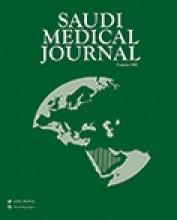Abstract
OBJECTIVES: To determine whether clinical and biochemical features of Graves' disease at presentation predict response to medical and radioiodine treatment.
METHODS: We carried out a retrospective 10-year study of 194 consecutive Saudi subjects with Graves' disease who were treated with antithyroid drugs, radioiodine therapy, or both, between January 1995 and December 2004 at King Khalid University Hospital, Riyadh, Saudi Arabia.
RESULTS: At diagnosis, the mean age was 32 ± 0.9 years. Only 26% of patients had successful outcome after a course of antithyroid medication. None of the clinical or biochemical factors were associated with a favorable outcome of antithyroid treatment. One dose of radioiodine [13-15 mCi (481-555 MBq)] cured hyperthyroidism in 83% of patients. Presence of ophthalmopathy at presentation was shown to be a significant contributing factor to failure to respond to a single dose of radioiodine (odds ratio, 6.4; 95% CI, 1.51-24.4; p<0.01). Failure of radioiodine treatment was also associated with higher serum free T3 concentration at presentation (p=0.003).
CONCLUSIONS: In patients with Graves' hyperthyroidism, radioiodine treatment is associated with higher success rate than antithyroid drugs. A dose of 13-15 mCi (481-555 MBq) seems to be practical and effective, and should be considered as first line therapy. Patients with high free T3 concentration and, those with ophthalmopathy at presentation were more likely to fail radioiodine treatment. A higher dose of radioiodine may be advisable in such patients.
- Copyright: © Saudi Medical Journal
This is an open-access article distributed under the terms of the Creative Commons Attribution-Noncommercial-Share Alike 3.0 Unported, which permits unrestricted use, distribution, and reproduction in any medium, provided the original work is properly cited.






